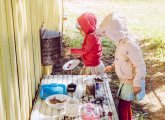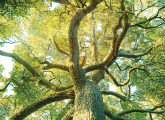As the winter bites, why not take advantage of the frozen conditions to explore the amazing aesthetic properties of ice? Susan Rowe and Susan Humphries recount an inspiring and finger-numbing project…
During a period of sub-zero temperatures in 2012, the skies were cloudless and the soil remained frozen to a depth of about 12-inches. The intense light and cold meant that 70 young children were able to make a new connection to their school landscape by working outside with natural materials and water…
The children collected holly, hawthorne and ivy leaves, strands of moss, splintered stalks made brittle by the frost, pine needles and cones, and more from the school gardens. The areas adjoining the classroom were to become exhibition centres for ephemeral art encapsulated in ice. Teachers provided a mixture of shallow containers so that there was some trial and error in the children’s choices of shape and size. Then the children scattered or ordered their collections into their chosen containers and covered them with water. They were then helped to set a loop of cord in each dish so that the anticipated ice sheets could be suspended for display. All the containers were named and positioned alongside the pathways next to the classrooms.
The children felt sure that the collections would be different the next day and, sure enough, the following morning the water in the dishes had frozen solid and was covered with rime. The sets of fragments had been fused into a whole, resulting in very satisfying compositions. Together, adults and children brushed away frost and turned the ice sheets out onto the grass. Once released from the containers the simple patterns were accentuated by light and appeared as artistic forms of extraordinary purity.
During the excitement some of the panes of ice fractured, but the interactions as children first held the sheets at close range and then looked at each other through the ice were exuberant, social and educational. When the children put their sheets of ice above their heads and looked up into them, the light projected soft shadows of the shapes within onto their faces, and they saw their objects in relief against the light.
The many broken bits of ice were stood at an angle against a wall: these fragments became the ‘touch and test’ elements of the exhibition. The remainder became the first sheets to be hung from the trees by the cords secured in the ice. The cords were tied to branches at a variety of fairly low levels so that the hanging ice work could respond to breezes, be accessible for gentle touching and make viewing possible from many angles.
The fullest benefit of working with the weather comes when there is a dependable period in which temperatures and light quality remain relatively steady. Our weather forecasters warned of temperatures below freezing both night and day and warned of strong glare from the sun. On this basis, the children were asked if they would like to continue their work: they wanted to dress all the trees in glittering ice designs.
It was agreed that we should concentrate on those trees that were nearest to the classroom windows. At the supermarket, we collected fruit and vegetables that had dateexpired. We hoped for some heightened special effects and surprises, and these came from the vividness of green vegetables encased in ice; the colour of all green specimens was brightened up by freezing. Beetroot faded but displayed its concentric growth circles in thin, white bands, potatoes turned grey, bean sprouts overspread each other and presented themselves in blizzardlike patterns. Tomatoes burst their skins. Horizontal slices of citrus fruit were particularly good subjects. All the objects looked significant and fascinating in their unconventional settings.
The children then wanted to increase the span of objects and to mix fruit with vegetables and flowers. We collected flowers that the children spontaneously deconstructed and added to their work. The flowers’ centres and petals called attention to form and colour and was another detail that embellished the finished work. In the course of making and hanging the artwork, the children had been cooperating, experiencing joint ownership of the works, making discoveries and making mistakes. A useful and rewarding enterprise carries a degree of risk, which is necessary in order to attain certain competencies. Children held their ice work and it fell through their cold hands and shattered. Other children saw this and the loss became a benefit since it added to the group’s collective knowledge. We learn from each other and by having to deal with setbacks as well as successes.
In three or four instances, where strong rays of sunlight constantly reached certain pieces of artwork, very fine droplets of melt water slowly grew into ice needles suspended underneath. The edges of these thin icicles were finely saw-toothed, adding extra reflective surfaces to scatter the light. There were conspicuous visual contrasts in the display of which this was the most striking. The vocabulary required to describe adequately the effects would be well suited to much older children. We used words such as ‘transparent’, ‘opaque’, ‘translucent’, and ‘scintillating’, but felt that too much teaching could restrict our young children’s spontaneous language.
Ice and fire when put together can be perfect partners. We experimented with enclosing candles in ice but failed at keeping the flame burning. We then started to make ice lanterns. These could be made using all sorts of moulds but the best shape was cylindrical with a hollow container inserted dead centre.
When the outer mould was a large plastic pudding basin and the inner mould was a plastic beaker (filled with dry sand to ensure the sand would not freeze and for stability) we got reliable and attractive lanterns.
The inner container provides the space for a votive candle or nightlight when it is removed. The outer bowl is the light chamber and its form maximises the light. All the children wanted to make one of their own and they individualised them with berries, leaves and petals in the sides. We noted that strong colours were the best choices. Mistletoe berries and white petals were too subtle and got lost in the overall design.
At all times during our project, the children’s display received a great deal of attention from parents and carers, who saw the installation grow day by day. Nearly half of the children involved in this integrated science/art project replicated details of it in the garden or backyard when they got home. This was child-generated with support from parents who had been touched by this form of expression with its clarity, vibrancy of appeal and worthwhile results.

Messy play activities – Grasping new skills
Editors picks

Immerse yourself in nature
Editors picks

Teach Early Years Awards – 2024 shortlist announced
Editors picks
